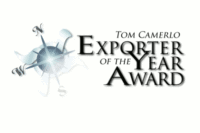This year’s recipient of the Tom Camerlo Exporter of the Year award from Dairy Foods stands out from the competition in one major way: fewer frequent flyer miles. At least, fewer miles traveled between its export markets and headquarters. After all, when you’ve already got personnel stationed in those markets, there’s no need to visit as often — your company already lives there.
This is but one lesson to glean from the Glanbia USA export model, which also offers insight on growing a healthy domestic and export business side-by-side and a new view of the so-called “risks” of exporting.
Glanbia USA, a division of the Irish-headquartered Glanbia plc, includes the cheese and whey processing unit Glanbia Foods, headquartered in Twin Falls, Idaho, as well as Glanbia Nutritionals Ingredient Technologies, based outside of Madison, Wis., which creates and markets dairy-based nutritional and functional ingredients.
Glanbia USA had its beginnings as cheese and whey operations in Monroe, Wis., before being expanded West with the purchase of Idaho-based Ward’s Cheese Inc. by Avonmore Foods plc, the Irish predecessor of Glanbia plc, in 1990. Avonmore later changed the name of Ward’s Cheese, which itself had started out in 1907 as the Nelson-Ricks Creamery, to Avonmore West Inc. After merging with Waterford plc, the entire Avonmore family of companies underwent a name change in 2000 to Glanbia, an Irish word meaning “pure food.”
Glanbia USA and its predecessors began exporting decades ago. The company has four plants in Idaho, located in Gooding (one plant produces cheese and another produces ingredients), Richfield (ingredients) and Twin Falls (cheese). They process roughly 12 million pounds of milk a day. But the heat really got turned up when Southwest Cheese Inc., the company’s giant cheese processing joint venture with Dairy Farmers of America and Select Milk Producers Inc. in Clovis, N.M., got underway in 2006. Southwest Cheese is capable of processing 4 billion pounds of milk annually.
In 2007, Glanbia Foods expanded its Gooding capacity to produce an additional 8.5 million pounds of lactose and 5 million pounds of WPC annually. Not including Southwest Cheese, the company currently processes more than 4 billion pounds of milk each year. Annual sales are more than $850 million. With total sales of $1.6 billion, Glanbia Foods ranks 22 on the Dairy 100, Dairy Foods’annual list of North America’s largest dairy processors.
Tailor-made products
Glanbia Nutritionals excels at innovating. It has earned a reputation for partnering with its customers, many of whom operate globally, to develop and deliver complete, tailor-made dairy proteins, specialty dairy ingredients and bioactive whey peptide solutions. Its exports include whey protein isolate, whey protein concentrate, whey hydrolysate, milk protein isolate, milk protein concentrate, lactoferrin, whey blends, whey peptides, lactose and milk minerals. The company currently sells to customers in 45 countries.
But innovation without direction is like digging a big hole in the wrong field, notes Jerry O’Dea, president and CEO, Glanbia Nutritionals.
“Innovation is a huge piece of what we’re all about,” said O’Dea. “It sounds simple: Give the customers exactly what they want. But it takes a lot of contact with the customer, and understanding the customers’ business plans so Glanbia can work on ingredients that will help them sell more products… ingredients that are versatile and appealing. That’s a lot of what we do. We try to think ahead to create ingredients that will make our customers successful. You must stay one step ahead of the customer, offering insight into how dairy ingredients can help them outperform their competition. You have to bring your expertise to the table and work like a member of their R&D team.”
Getting and staying close to customers in this manner requires a long-term commitment to establish the trust necessary to ensure they will share such opportunities with you, he added.
“That’s the value of being close to the customer — so that they’ll share with you where they’re going and so that they trust you to help make them more successful,” O’Dea said.
Clearly, that trust is there: Glanbia Nutritionals’ dairy ingredients exports are up almost 42% since 2006.
Of special note, the company’s functional dairy ingredients have started to find footing in export markets, including its range of bar solutions and its portfolio of dairy-based OptiSol functional ingredient systems, which experienced 327% growth since 2006 in Europe, the Middle East and Africa. In addition, lactoferrin has seen consistent growth in volume both in those markets and in the Asian markets since 2006. Specialty whey peptides such as CFM Nitro P have experienced a 1,000% growth.
Relationship management
So just how big is Glanbia USA’s international team? Plenty big — and growing. Glanbia USA has offices and/or personnel in Mexico City, Rio de Janeiro, Uruguay, Brazil, Belgium, Germany, the United Kingdom, Dubai, Singapore, Shanghai, Beijing, Tokyo and Sydney. And the company plans to expand the number of people that are direct Glanbia USA employees stationed in global markets “to demonstrate our commitment to serve those markets as well as to deliver relevant information back to our corporate locations in the U.S. and Ireland,” said Glanbia Foods president and CEO Jeff Williams.
“In those parts of the world where we have Glanbia employees or a long-term representative, the relationships with key accounts in those markets are much stronger,” said Dave Snyder, vice president, global business development — cheese, Glanbia Foods.
According to Dan Duran, director of international cheese sales, Glanbia Foods, establishing that relationship is the foundation for growth.
“Then you are able to gain levels of trust to bring new forms of products and support which in turn enable you to maintain and grow the relationship, plus gain new business,” Duran said.
“Glanbia USA’s strategic market development and willingness to make what the customer wants or needs has made the company a trusted partner for many global dairy buyers,” said Tom Suber, president of the U.S. Dairy Export Council, Arlington, Va. “That trust comes not only from delivering what they said they would, but also from having a representative on the ground to help its customers with any questions or additional needs that may arise. Glanbia USA is second-to-none in its commitment to in-market personnel, and it shows.”
Gouda for Mexico
Still, company leaders aren’t satisfied with growing “just” the ingredients portion of its business. Glanbia USA has worked hard to grow its cheese exports in recent years — and at a good clip.
“We could probably build another Southwest Cheese every five years, but we want to produce more than just commodity cheese,” Williams said.
Instead, Glanbia USA develops tailor-made cheeses for its customers. For example, Glanbia Foods worked with USDEC staff several years ago to develop a U.S.-made Gouda specifically for the Mexican market. Recognizing that roughly half of the cheese consumed in Mexico is a dry Gouda (something the United States was not producing), USDEC embarked on a program to encourage U.S. Gouda capabilities to serve this growing market. Glanbia Foods jumped in feet first and now supplies a significant amount of Gouda to Mexico annually.
This customer-focused spirit plays a big part in the company’s growth. Glanbia is on track to account for more than 10% of all U.S. cheese exports in 2012.
Glanbia Foods recently broke ground on a new cheese innovation center in Twin Falls, Idaho. This $15 million project includes a three-story, 35,000-square-foot office complex along with a 14,000-square-foot research center to support the company’s growing export and new cheese product innovation efforts. The site is slated to open in summer of 2013.
Wisdom from abroad
Glanbia USA executives all say the same thing: Getting the sale isn’t the hard part, despite any cultural or language barriers. Keeping the customer is what takes the most effort.
“Many (export business) fundamentals are universal,” Snyder said. “It’s really not all that different from how we do our business in the U.S. We get to know the people that we want to do business with and understand what their needs are and try to respond as quickly and efficiently as possible to those needs. We treat that as fundamental business practices, whether we’re doing business with Mexico or Japan or China.”
“You have to understand your own capabilities — that’s very important,” Duran added. “And you have to be confident in your willingness to adapt to the structures, the programs and the process of exporting. The selling part is not as difficult as people think it is, but you have to be willing to adapt your business to the international marketplace.”
And you have to be willing to occasionally take it on the chin short-term in order to serve the market long-term, Williams added.
Still, although many people see exporting product as risky for that very reason, Glanbia USA uses exports to help diversify its business and actually mitigate risk, O’Dea noted.
“When there are downturns in the market, you have more options to place your product,” he said. “If you’re purely focused on the U.S., you’re going to have to deal with just what happens there. But during a downturn, Asia might be strong, Brazil might be strong, and since we are already in those markets, we can send product to those markets. But it also means that there’s less product here in the States and so it improves the prices here, too. I’ve seen faster recoveries of downturns in the U.S. because we were able to move product to the EU or Latin America — and others have done the same — so then it recovers in three months versus six months.”
Snyder also mentions Glanbia USA’s efforts to help its customers identify ways to improve their products or services.
“That’s what they’re looking for” from business partners, Snyder said. “It’s not a secret formula. It’s about quality, service, innovation and competitive pricing, no matter where the sale may take place.”
Finally, stay positive. Growth is there for the claiming, Snyder said.
“We’re so optimistic about current and future opportunities,” Snyder added. “I’ve been doing this for a long time, but I’ve never seen the degree of opportunity and excitement that is felt and exists with global trade opportunities. The domestic market, too. But the developments in the global market are so phenomenal that it’s like having a whole new career opportunity without having to change companies.”
The vision of Tom Camerlo
The Tom Camerlo Exporter of the Year award is named for the visionary former chairman of the U.S. Dairy Export Council whose steadfast determination that American dairy companies look to the global market for growth has helped transform the industry. It is presented annually to a company that demonstrates leadership in driving global dairy demand and advancing U.S. dairy exports as well as commiting resources to export market development and making exports central to its overall growth strategy.
Duran mentions having known Camerlo, and said that being named the Dairy FoodsExporter of the Year is magnified by the vision of its namesake.
“The beauty of an award like this is that it reflects what Tom believed in and what USDEC represents — that one world, one market outlook,” Duran adds. n
Glanbia exports around the world
Cheese export markets:Algeria, Australia, Bahrain, Brazil, China, Dominican Republic, Egypt, El Salvador, Guatemala, Indonesia, Iraq, Japan, Jordan, Korea, Libya, Malaysia, Mexico, Morocco, Netherlands, Nicaragua, Panama, Philippines, Saudi Arabia, Singapore, South Africa, Taiwan, Tunisia and Venezuela
Dairy ingredients export markets:Argentina, Austria, Australia, Belgium, Brazil, Canada, Colombia, Switzerland, Chile, China, Costa Rica, Czech Republic, Germany, Denmark, Ecuador, Spain, Finland, France, United Kingdom, Greece, Hungary, Indonesia, Ireland, India, Iceland, Italy, South Korea, Mexico, Malaysia, Netherlands, Norway, New Zealand, Paraguay, Philippines, Poland, Romania, South Africa, Sweden, Singapore, Thailand, Taiwan, Uruguay, Venezuela and Vietnam






